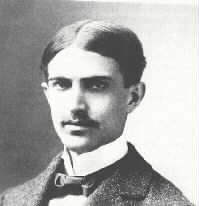Sing Ruby Siu
English 48B
February 12, 2009
Journal #11 Stephen Crane
QUOTE:
“The girl, Maggie, blossomed in a mud puddle. She grew to be a most rare and wonderful production of a tenement district, a pretty girl” (967).
SUMMARY:
In Maggie, Ch. V, the little girl, who dragged her little brother around, has grown into a young girl. Living all her life in the chaotic Rum Alley, she grew up in a district with serious violence, brutality and poverty. After the death of her little tot brother, the only family members who were beside her were her drunken mother, weak father and her brother Jimmie, who consistently engaged himself in fights due to pride. Lived and being perceived as one of those uneducated kids, she surprisingly turned out to be a pretty girl.
RESPONSE:
“Crane's first novel is the tale of a pretty young slum girl driven to brutal excesses by poverty and loneliness” (Online-literature.com). The fall of Maggie was the central focus of the story because Crane wants to emphasize that even a girl as good as Maggie can be severely influenced by the environment. In the above quote, the use of the verb, “blossomed,” signified the fact that Maggie was originally born as pretty as flowers. The symbolic meanings of flowers implied on Maggie include beauty, sexy, allure and value. However, this very flower blossomed in a “mud puddle,” which symbolically refers to the terrible, vulgar and complicated area in which Maggie lived. The big contrast in this very short sentence summarizes the theme behind the story, which is: no matter the quality of a person, environment will act on as a gigantic assimilating force acted on a person’s character development and acts.
To a broader extent, every figure represents the failure of Irish immigrants in every aspect. Everyone in the story mistakenly came to America with their “American Dream” but they were all driven to some unfavorable or unfortunate extremity in the book. For example, in the opening of the story, we can see how Jimmie was obsessed in fights and pride gained from victory. He represents a number of Irish youths who instead of studying positively, wrongly devoted their energy and focuses into some bloody, brutal gangster businesses. Pete, the bartender, who represents a medium between low-class and middle-high class Americans at that time. He, however, clang onto the margin of middle-high class life by proactively and professionally networking with people and he many times omitted his real needs and desires-his love for pure and innocent gir ls, like Maggie. People just like Pete competed for the best by all means to assimilate well into the society and yet they might live in pains that were even unnoticed by them.
ls, like Maggie. People just like Pete competed for the best by all means to assimilate well into the society and yet they might live in pains that were even unnoticed by them.
Jimmie and Maggie’s mother, Mary, represents an irresponsible, jobless and uneducated parent who does not know how to care for her children and herself. Sunk in the sea of alcohol, Mary can be consciously escaping from the reality of unemployment, disgraceful children and useless husband. In the story, we can see she indulged herself by drinking and always acted furiously. This might also be a way for her to release her anger and sentiment toward her life and environment. Showing no special effort to communicate with her children, she still claimed that she had done all the best things a parent could do to teach Maggie. This shows either she really does not attain sufficient knowledge in parental care, or she obviously tries to sooth her own emotion by formulating some lies. In the process of lying, she successfully shrugged off her responsibility to her daughter or Pete, so that she would become free and sinless again.
Maggie was the last one who was assimilated into this terrible surrounding. Crane portraits the change of her personality primarily based her thoughts and affection toward Pete. Crane wants to let the readers understand not only the existence of the slumps at that time, but to face the painful and inevitable transition of these people into slumps.



20 points. Wonderful observation: "To a broader extent, every figure represents the failure of Irish immigrants in every aspect. Everyone in the story mistakenly came to America with their “American Dream” but they were all driven to some unfavorable or unfortunate extremity in the book."
ReplyDelete